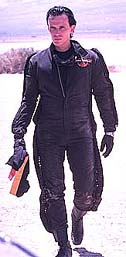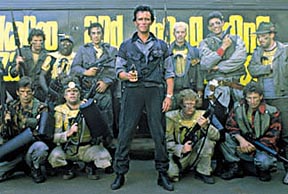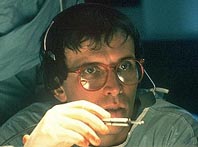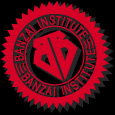
|
|
|
|
SOME HARD FACTS AND PERSISTANT RUMORS CONCERNING BUCKAROO BANZAI
By W.D. Richter
 My wife and I first
became aware of the man called Buckaroo Banzai over a decade
ago, when the astonishing extent of his exploits was suggested
late one night by Earl Mac Rauch during one of Rauch's infrequent
trips through Los Angeles. Like Buckaroo Banzai, Mac Rauch is
a Texan of sorts, and like Buckaroo a hard man to pin down. As
we became increasingly fascinated over the years with this strange,
elusive character, Rauch would elaborate on the achievements
and adventures of Dr. Banzai, who apparently was first and foremost
an extraordinary neurosurgeon.
My wife and I first
became aware of the man called Buckaroo Banzai over a decade
ago, when the astonishing extent of his exploits was suggested
late one night by Earl Mac Rauch during one of Rauch's infrequent
trips through Los Angeles. Like Buckaroo Banzai, Mac Rauch is
a Texan of sorts, and like Buckaroo a hard man to pin down. As
we became increasingly fascinated over the years with this strange,
elusive character, Rauch would elaborate on the achievements
and adventures of Dr. Banzai, who apparently was first and foremost
an extraordinary neurosurgeon.
Dissatisfied with a life devoted exclusively to medicine, Buckaroo Banzai perfected a wide range of skills. He designed and drove highpowered automobiles. He studied bujitsu and particle physics. His skill with a sixgun was reputed to eclipse that of Wyatt Earp. He spoke a dozen languages and wrote songs in all of them. His band, the Hong Kong Cavaliers, was one of the most popular, hardrocking bar bands in east Texas, though its members were not professional musicians at all but rather cartographers and botanists, linguists and propellant engineers, an entomologist and an epidemiologist. All of these experts in the oddest fields of endeavor were drawn to Buckaroo, and all of them came and went like the wind on the prairie Rawhide, Reno, the Swede, Perfect Tommy, Big Norse, Pecos.
Buckaroo Banzai, Rauch assured us, was a simple man, a peaceful man who knew well the ways of the warrior, a happy man whose life had been marked by great tragedy. Some people said he'd been married once, briefly, until a lethal force from the mysterious East struck down his bride. This evil force was someone or some thing called Hanoi Xan: The Spawn of Hell, The Pivot of Mystery, The Face That Is No Face.
Rauch told us that this Hanoi Xan was The Supreme Commander of the Legion of Death and the boss of The World Crime League, that he had years ago persecuted Buckaroo's father and would not rest until Buckaroo himself had been killed. We learned of The Strange Case of Mister Cigars and how time and time again Buckaroo Banzai had intervened to preserve the fragile order that exists on our small planet. It is whispered in diplomatic circles that three American presidents and one Persian sultan have sought from Buckaroo Banzai advice that, once given, altered the current of world events in a manner too profound to reveal.
You see the problem: of necessity only bits and pieces of information constitute our understanding of this remarkable man. Mac Rauch knows much more than he has so far shared with me, of that I am certain. It wasn't until six years ago that he finally acknowledged the existence of an elaborate, sophisticated network of Buckaroo Banzai's followers, The Blue Blaze Irregulars. Ordinary folk like you and me, these men and women go about the normal routine of their lives until that clarion call is sounded, until Buckaroo Banzai needs them. And then they're always there, at his side, helping him to help us. Team Banzai is how they refer to themselves, playing down their enormous contribution the same way Buckaroo Banzai has always played down his own.
 The
motto of the Hong Kong Cavaliers
and The Blue Blaze Irregulars? "Treat me good, I'll treat
you better. Treat me bad, I'll treat you worse." A highly
placed source in Washington (who asked not to be identified)
recently described Buckaroo and his trusted inner circle to a
senator I know rather well. "They are," he told this
senator with a mixture of admiration and frustration, "a
bunch of amateur international dogooders who spend half their
time battling man's inhumanity to man in every corner of the
globe and half their time playing that goddamn primitive rock
'n' roll music so loud you can't even hear yourself scream."
My friend the senator pointed out quite rightly that we need
more people like them. "If they're amateurs," he said,
"so be it. The word means those who do something for the
love of it.
The
motto of the Hong Kong Cavaliers
and The Blue Blaze Irregulars? "Treat me good, I'll treat
you better. Treat me bad, I'll treat you worse." A highly
placed source in Washington (who asked not to be identified)
recently described Buckaroo and his trusted inner circle to a
senator I know rather well. "They are," he told this
senator with a mixture of admiration and frustration, "a
bunch of amateur international dogooders who spend half their
time battling man's inhumanity to man in every corner of the
globe and half their time playing that goddamn primitive rock
'n' roll music so loud you can't even hear yourself scream."
My friend the senator pointed out quite rightly that we need
more people like them. "If they're amateurs," he said,
"so be it. The word means those who do something for the
love of it.
 Buckaroo Banzai.
He's out there, that's for sure. Kids read his comics, buy his
records. Surgeons study his techniques, and rocket scientists
steal his ideas. But who is he? I was fortunate to receive (from
a source other than Earl Mac Rauch) a group of remarkably candid
documents written by Buckaroo's mentor, Professor Toichi Hikita,
who is among other things the world's preeminent authority on
electromagnetic particle acceleration. I have photocopied some
pages from the professor's notebook of early 1979, and I beg
you to use discretion in distributing them since Buckaroo Banzai
has many enemies (in places you would perhaps least suspect)
and there might well be contained herein a single fact that could
be turned against him:
Buckaroo Banzai.
He's out there, that's for sure. Kids read his comics, buy his
records. Surgeons study his techniques, and rocket scientists
steal his ideas. But who is he? I was fortunate to receive (from
a source other than Earl Mac Rauch) a group of remarkably candid
documents written by Buckaroo's mentor, Professor Toichi Hikita,
who is among other things the world's preeminent authority on
electromagnetic particle acceleration. I have photocopied some
pages from the professor's notebook of early 1979, and I beg
you to use discretion in distributing them since Buckaroo Banzai
has many enemies (in places you would perhaps least suspect)
and there might well be contained herein a single fact that could
be turned against him:
[begin quote from Hikita's notes]
3/79
...that I will tell no man. I was with Buckaroo Banzai's father the night the child was born, and I held the boy in my arms that day five years later, that instant when his mother and father were killed.Throughout recorded history extraordinary events have catapulted ordinary men from the ranks of humanity and placed those individuals between the rest of us and catastrophe. Again and again the world has stood perched on the brink of disaster. Again and again those brave soldiers and statesman, those people forged of iron wills and steely intellect have at the last possible moment yanked us back to safety. Buckaroo Banzai, this child I have seen grow to manhood, is such a person. Once again, sad to say, the trumpet call of danger sounds all too loud and clear. Once again, I fear, a great man of the hour must emerge.
I speak thusly with a perspective offered me by my own personal history. In the middle years of the 1930's, I was hard at work with the man who would one day father Buckaroo Banzai. Masado Banzai was a pioneer in theoretical quantum mechanics, a man whose early notations of matrix and wave mechanics rattled Einstein and today excite the likes of roger Penrose and Stephen Hawking. We were children ourselves then -- and I mean this literally, not even in university -- when Masado Banzai first began to astound his teachers in Nagasaki. We worked together and studied together. I always tried desperately to understand him, to follow the way his mind leaped across problems to their solutions, just as his son's would 50 years later. I could never hope to anticipate him, but the challenge was exhilerating. Whatever I am today, I owe to Masado Banzai and to Sandra Willoughby, who became his wife.
They met in 1937 when she was only sixteen, and I believe they fell in love the moment they saw each other, although Masado, nineteen years old, certainly never let his feelings show. They would marry a dozen years later, much to the delight of Sandra's father, the wildly eccentric Scottish-born Texas mathematician, Edward McKay Willoughby. It was, in fact, Edward Willoughby who had arranged their meeting in the first place, inviting the rebellious young Japanese genius Masado Banzai to come visit the great state of Texas (payhing his way and the way of a friend -- me) to discuss as I recall his letter said, "the new meaning of probability."
So we journeyed to American in the fall of 1937. Masado stayed a month. I stayed forever, it seems. By 1938 I was hard at work in a small laboratory in Princeton, New Jersey, collaborating with a man whose life would soon take a most tragic turn: Dr. Emilio Lizardo, a brilliant Milanese guage theorist who believed as Masado Banzai and Sandra Willoughby and I did that man would one day be able to pass unharmed through solid matter.
Sandra Willoughby? In 1940, on the eve of her twentieth birthday, she set out for Nagasaki and Masado Banzai. By that time, under the tutelage of her father, this beautiful quiet yong Texas girl had taught herself more about the tantalizing new field of negative mass propulsion than even Masado Banzai knew. They worked together for almost a year and fled japan together in late November of 1941 a few short weeks before PearlHarbor. Masado, like his son, a man of peace, could not remain in a homeland that had turned to war.
With the world aflame, this Japanese man and this American woman made their way across treacherous borders, narrowly escaping death on three occasions, and after two years found themselves in Burma. It was there that Masado Banzai crossed swords with a villainous wretch known throughout the Orient by the pathetic nickname he had given himself: "The Herald of Peace/The Scourge of Burma." Hanoi Xan. Sworn to walk in hidden ways by The oath of The Flying Fish, this Xan would say proudly to the smallest child, "All my days have I done evil." He tried to murder Masado Banzai and Sandra Willoughby when the refused to teach him the secrets of science they knew. He failed, perhaps his only failure in those heady dark days when evil ruled this planet.
By 1946 my dear friends were safe in America. Although I was no longer working with Dr. Emilio Lizardo and my ideas were held in little esteem by the post-war American government, Edward McKay Willoughby intervened once more and obtained for Sandra, Masado, and me a small grant at the Texas School of Mines. Sir Godwin Lloyd-Jons journeyed from Cambridge England to join our research team in the Texas hinterlands.
In 1949 Sandra became pregnant; in the winter of 1950 on a trip to London with Masado (a trip her doctors advised against), she experienced the the difficult birth of her first and only child, Buckaroo Banzai. Enamored of the great american west, Masado insisted upon the boy's being called "Buckaroo," a naive tribute to his adopted homeland.
The next five years were a time of great hope and progress. We made significant strides in developing the primitive device that Dr. Lizardo and I had first invented in 1938 -- the Oscillation Overthruster, a rather small colliding beam accelerator whose purpose was to enhance the electroweak forces that pertain between sub-atomic particle, thus making those forces the most powerful events occuring within the atom. If we could do this we could separate matter! Not "explode" it as our colleagues in The Manhatten Project had done, but separate it, move right through it.
We were right, I know that now. But we were also impetuous. Arrogant. Excited. We were living dangerously. Then something went wrong. Not with our theory but with our equipment. A wire? A fuse? Sabotage? I have spent hours years since then agonizing over that moment and it is only lately and only because of Buckaroo Banzai that I have stopped wondering and stopped dwelling in the past.
I will give you just the coldest fact. Masado Banzai and British race car driver George Campbell were in the cockpit of the jet vehicle we had built to penetrate solid matter. Sandra and I were (with young Buckaroo) in a smal sand-bagged shelter where we had set up our monitoring instrumentation. A low rumbling began in the jet vehicle and then white smoke billowed out.
Sandra raced from the shelter to assist her husband and George Campbell. The young boy, Buckaroo Banzai, rushed after his mother. My able assistant Lawrence Steadman was filming all of this for our archives on 16mm Kodak color film. I rush out and realized the vehicle was about to explode. Sandra was strugglingto pry open its cockpit and I did the only thing I could. I grabbed the boy and hurled him back against the sandbags lest he too be killed.
The next fifteen years of my life were every difficult, and it is only because of Buckaroo that I chose to live them at all.
----------------------------
So ends Professor Toichi Hikita's account of the earliest years
in this saga. I will share with you now yet another page from
this intriguing story, a page written by Buckaroo Banzai himself.
Earl Mac Rauch contends it is the only time Dr. Banzai has ever
discussed himself in print. It is certainly the only example
I know of, and I'm afraid that its tone is so reserved, so "Eastern"
in a way, that very little of the man's great exuberance and
lust for life is apparent. His music gives us that:

FOR BIOMEDICAL ENGINEERING &
STRATEGIC INFORMATION
NEW BRUNSWICK, NEW JERSEY
It was quite by chance that I became involved in scientific investigation and began to study the psychology of crime. Although I was born in London during a visit of my parents to England, I spent my early days on the vast ranges of Colorado and Arizona and there was taught how to ride and shoot by the redskinned Sioux warriors, who strangely seemed to enjoy showing an Amerasian boy their tricks. Until I was fourteen I went to school in Denver and later I continued my education in Massachusetts, Texas, and England, taking my medical degree from Harvard. In this way a love of travel and the craving for excitement and danger were stimulated in me from childhood.
After my first introduction in Monte Carlo to the forces which wage unceasing warfare against the shadowy underworld of crime, I realized that in their ranks was a possibility of escaping from the dreaded monotony of a life of routine.
I don't know how much else to tell you here because, as Buckaroo
himself said, "If all wishes were gratified, many dreams
would be destroyed." When I asked Mac Rauch if we were spilling
too many beans here, he reminded me of a question Buckaroo Banzai
put to a group of prospective Blue Blaze Irregular recruits:
"You ever eat all you can eat and still not be satisfied?"

|
|
|
|